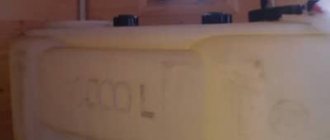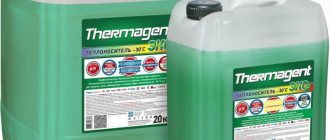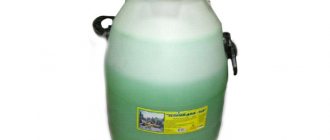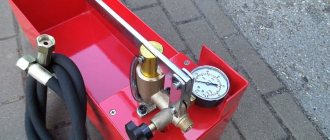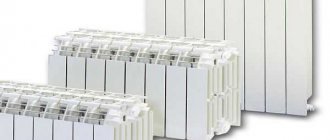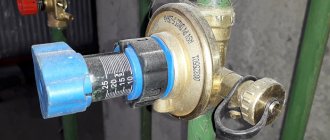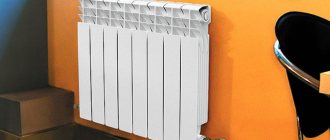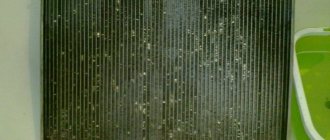Temperature graph of the heating system - calculation procedure and ready-made tables
The basis for an economical approach to energy consumption in a heating system of any type is the temperature schedule. Its parameters indicate the optimal value for heating water, thereby optimizing costs. In order to apply this data in practice, it is necessary to learn in more detail the principles of its construction.
Terminology
Temperature graph - the optimal heating value of the coolant to create a comfortable temperature in the room. It consists of several parameters, each of which directly affects the quality of operation of the entire heating system.
- Temperature in the inlet and outlet pipes of the heating boiler.
- The difference between these coolant heating indicators.
- Temperature indoors and outdoors.
The latter characteristics are decisive for the regulation of the first two. Theoretically, the need to increase the heating of water in the pipes occurs when the temperature outside decreases. But how much do you need to increase the boiler power in order to heat the air in the room optimally? To do this, draw up a graph of the dependence of the parameters of the heating system.
- 150°C/70°C. Before reaching the users, the coolant is diluted with water from the return pipe to normalize the incoming temperature.
- 90°C/70°C. In this case, there is no need to install equipment for mixing the flows.
According to the current system parameters, utilities must monitor compliance with the heating value of the coolant in the return pipe. If this parameter is less than normal, it means that the room is not heated properly. Exceeding indicates the opposite - the temperature in the apartments is too high.
Temperature chart for a private house
The practice of drawing up such a schedule for autonomous heating is not very developed. This is explained by its fundamental difference from the centralized one. The water temperature in the pipes can be controlled manually or automatically. If the design and practical implementation took into account the installation of sensors for automatically regulating the operation of the boiler and thermostats in each room, then there will be no urgent need to calculate the temperature schedule.
But it will be indispensable for calculating future expenses depending on weather conditions. In order to draw it up in accordance with the current rules, the following conditions must be taken into account:
- Heat losses at home should be within normal limits. The main indicator of this condition is the heat transfer resistance coefficient of the walls. It varies depending on the region, but for central Russia you can take the average value - 3.33 m²*C/W.
- Uniform heating of living spaces in the house when the heating system is operating. This does not take into account the forced decrease in temperature in one or another element of the system. Ideally, the amount of thermal energy from the heating device (radiator), as far as possible from the boiler, should be equal to that installed close to it.
Only after these conditions have been met can we proceed to the calculation part. Difficulties may arise at this stage. Correct calculation of an individual temperature schedule is a complex mathematical scheme that takes into account all possible indicators.
However, to make the task easier, there are ready-made tables with indicators. Below are examples of the most common operating modes of heating equipment. The following input data were taken as initial conditions:
- Minimum air temperature outside - 30°C
- The optimal room temperature is +22°C.
Based on these data, schedules were drawn up for the following types of operation of heating systems.
It is worth remembering that these data do not take into account the design features of the heating system. They only show the recommended temperature and power values of heating equipment depending on weather conditions.
eco-sip.ru
- putty
- Building a wall
- Painting
- Wallpaper
- Decorating the walls
- Facade panels
- Other materials
Coolant and its parameters
Coolant (working fluid) is a gaseous or liquid substance used in machines for energy conversion, in the case of heat exchange to produce heat or cold.
In boiler rooms, the coolants are water and steam, the main physical characteristics of which are temperature, pressure, specific volume or density. Temperature is a measure of the thermal state or degree of heating of a body. The thermal state of a body is characterized by the average internal energy of the body, the intensity of thermal vibrations of its atoms. The higher the temperature, the greater it is. Body temperature can increase or decrease depending on whether heat is supplied or removed from the body as a system.
Pressure is a quantity that characterizes the ratio of a normally (perpendicular to the surface) directed force to the surface area on which it acts. In the heating industry, three types of pressure are most widespread - atmospheric, excess and absolute.
Atmospheric is the pressure of air on the ground and on objects located on it. A device for measuring atmospheric pressure is called a barometer in meteorology, and the pressure itself is called barometric and is designated Pbar.
Excess pressure P from6 characterizes its excess above atmospheric pressure. This pressure is measured by a manometer, therefore it is also called manometric.
Absolute pressure Pabs is the pressure of a liquid or gas in a closed vessel. It is equal to the sum of atmospheric and excess pressure:
Absolute pressure can be greater or less than atmospheric pressure. If the pressure is below atmospheric, it is called rarefaction (vacuum). If the pressure in a closed vessel is less than atmospheric, then:
In practice, the following multiples of pascal units are used:
0.1 MPa); mmHg Art. (millimeters of mercury, 1 mm Hg = 133 Pa); mm water Art. (millimeters of water column, 1 mm of water column = 9.81 Pa).
All these pressure units are related to each other using appropriate conversion factors.
Physical atmosphere (air pressure at sea level equal to 760 mm Hg at a temperature of 0 ° C)
The specific volume V0 of a gas, water or steam is the volume of a unit mass of a substance. For example, for a gas with a volume V m3 and a mass t, kg, the specific volume, m3/kg, will be:
The density p of gas, water or steam, as well as any solid substance, kg/m3, is the reciprocal of the specific volume:
Source
The speed of water movement in the pipes of the heating system.
During the lectures we were told that the optimal speed of water movement in the pipeline is 0.8-1.5 m/s. On some sites I see something similar (specifically about the maximum of one and a half meters per second).
BUT the manual says to take losses per linear meter and speed - according to the appendix in the manual. The speeds there are completely different, the maximum that is on the sign is just 0.8 m/s.
And in the textbook I came across an example of a calculation where the speeds do not exceed 0.3-0.4 m/s.
So what's the point? How to take it in general (and how in reality, in practice)?
I am attaching a screenshot of the sign from the manual.
Thank you all in advance for your answers!
What do you want? Should you find out “military secrets” (how to actually do it), or pass the coursework? If only a course student - then according to the manual, which the teacher wrote and does not know anything else and does not want to know. And if you do it right
, won’t accept it yet.
0.036*G^0.53 - for heating risers
0.034*G^0.49 - for mm mains of the branch, until the load is reduced to 1/3
0.022*G^0.49 - for the end sections of a branch with a load of 1/3 of the entire branch
In the coursework, I calculated it according to the manual. But I wanted to know how things were going.
That is, it turns out in the textbook (Staroverov, M. Stroyizdat) is also not correct (speeds from 0.08 to 0.3-0.4). But perhaps there is only an example of calculation.
Offtop: That is, you also confirm that, in essence, the old (relatively) SNiPs are in no way inferior to the new ones, and in some cases even better. (many teachers tell us about this. In general, the dean of the PSP says that their new SNiP largely contradicts both the laws and himself).
But in principle everything was explained.
and the calculation to reduce diameters along the flow seems to save materials. but increases labor costs for installation. If the labor is cheap, it might make sense. if labor is expensive, there is no point. And if over a long length (heating main) changing the diameter is beneficial, fussing with these diameters within the house does not make sense.
and there is also the concept of hydraulic stability of the heating system - and here the ShaggyDoc schemes win
We disconnect each riser (upper wiring) from the main line with a valve. I've seen that double adjustment taps are installed immediately after the valve. Is it advisable?
And how to disconnect the radiators themselves from the connections: with valves, or install a double adjustment tap, or both? (that is, if this valve could completely shut off the pipeline, then the valve would not be needed at all?)
And for what purpose are pipeline sections isolated? (designation - spiral)
The heating system is two-pipe.
I need to know specifically about the supply pipeline, the question is above.
We have a coefficient of local resistance to the flow input with a turn. Specifically, we use it at the entrance through the louvered grille to the vertical channel. And this coefficient is 2.5 - which is quite a lot.
That is, how to come up with something to get rid of this. One of the exits is if the grille is “in the ceiling”, and then there will be no turning entrance (although there will still be a small one, since the air will be drawn along the ceiling, moving horizontally, and move towards this grille, turn in a vertical direction, but along logically it should be less than 2.5).
You can't put bars in the ceiling in an apartment building, neighbors. and in a single-apartment building, the ceiling will not be beautiful with bars, and debris can get in. that is, the problem cannot be solved this way.
I often drill, then plug
Take the thermal power and the initial from the final temperature. Based on these data, you can absolutely reliably calculate
speed. It will most likely be a maximum of 0.2 m\S. Higher speeds require a pump.
Calculation of coolant movement speed in pipelines
When designing heating systems, special attention should be paid to the speed of movement of the coolant in the pipelines, since the speed directly affects the noise level. According to SP 60.13330.2012
Set of rules. Heating, ventilation and air conditioning. Updated version of SNiP 41-01-2003 maximum water speed in the heating system is determined from the table
According to SP 60.13330.2012. Set of rules. Heating, ventilation and air conditioning. Updated version of SNiP 41-01-2003, the maximum water speed in the heating system is determined from the table.
| Permissible equivalent noise level, dBA | Permissible speed of water movement, m/s, in pipelines with local resistance coefficients of the heating device unit or riser with fittings reduced to the speed of the coolant in the pipes | ||||
| Up to 5 | 10 | 15 | 20 | 30 | |
| 25 | 1.5/1.5 | 1.1/0.7 | 0.9/0.55 | 0.75/0.5 | 0.6/0.4 |
| 30 | 1.5/1.5 | 1.5/1.2 | 1.2/1.0 | 1.0/0.8 | 0.85/0.65 |
| 35 | 1.5/1.5 | 1.5/1.5 | 1.5/1.1 | 1.2/0.95 | 1.0/0.8 |
| 40 | 1.5/1.5 | 1.5/1.5 | 1.5/1.5 | 1.5/1.5 | 1.3/1.2 |
Notes
|
calceng.ru
What could be the consequences of narrowing the diameter of the heating pipe?
Narrowing the pipe diameter is extremely undesirable. When wiring around the house, it is recommended to use the same standard size - there is no need to increase or decrease it. The only possible exception would be a large length of the circulation circuit. But even in this case you need to be careful.
But in this same situation, it turns out that the residents who made such a replacement of pipes automatically “stole” approximately 40% of the heat and water passing through the pipes from their neighbors in this riser. Therefore, it is worth understanding that the thickness of pipes that are arbitrarily replaced in a heating system is not a matter of private decision; this cannot be done. If steel pipes are replaced with plastic ones, no matter how you look at it, you will have to widen the holes in the ceilings.
There is such an option in this situation. When replacing risers, you can pass new pieces of steel pipes of the same diameter into the old holes; their length will be 50-60 cm (this depends on such a parameter as the thickness of the ceiling). And then they are connected with couplings to plastic pipes. This option is quite acceptable.
Data on how to calculate the diameter of a heating pipe
To calculate the diameter of the pipeline, you will need the following data: this is the total heat loss of the home, the length of the pipeline, and the calculation of the power of the radiators in each room, as well as the wiring method. The outlet can be one-pipe, two-pipe, have forced or natural ventilation.
Unfortunately, it is impossible to accurately calculate the pipe cross-section. One way or another, you will have to choose from a couple of options. This point is worth clarifying: a certain amount of heat needs to be delivered to the radiators, while achieving uniform heating of the batteries. If we are talking about systems with forced ventilation, then this is done using pipes, a pump and the coolant itself. All that is needed is to drive the required amount of coolant over a certain period of time.
It turns out that you can choose pipes of a smaller diameter and supply the coolant at a higher speed. You can also make a choice in favor of pipes of a larger cross-section, but reduce the intensity of the coolant supply. The first option is preferable.
The influence of temperature on the properties of the coolant
In addition to the factors described above, the temperature of the water in the heating pipes affects its properties. This is the basis of the operating principle of gravity heating systems. As the heating level of water increases, it expands and circulation occurs.
Coolants for heating systems
However, if antifreeze is used, exceeding the normal temperature in the radiators can lead to different results. Therefore, for heating with a coolant other than water, you should first find out the permissible heating rates. This does not apply to the temperature of central heating radiators in the apartment, since such systems do not use antifreeze-based liquids.
Antifreeze is used if there is a possibility that low temperatures will affect radiators. Unlike water, it does not begin to change from a liquid to a crystalline state when it reaches 0°C. However, if the heat supply operation exceeds the norms of the temperature table for heating to a greater extent, the following phenomena may occur:
- Foaming. This entails an increase in the volume of coolant and, as a result, an increase in pressure. The reverse process will not be observed when the antifreeze cools;
- Formation of limescale. Antifreeze contains a certain amount of mineral components. If the heating temperature in the apartment is violated, they begin to precipitate. Over time, this will lead to clogged pipes and radiators;
- Increasing the density index. Malfunctions of the circulation pump may occur if its rated power was not designed for such situations.
Therefore, it is much easier to monitor the water temperature in the heating system of a private home than to control the degree of heating of antifreeze. In addition, when evaporating, ethylene glycol-based compounds emit gas that is harmful to humans. Currently, they are practically not used as a coolant in autonomous heat supply systems.
Before pouring antifreeze into the heating, you should replace all rubber gaskets with paranitic gaskets. This is due to the increased permeability of this type of coolant.
Antifreeze
So, if you have chosen antifreeze, then you should know that it should not be easily flammable, and it should not contain poisonous or toxic substances.
Important! Do not use antifreeze, ethyl alcohol or transformer oil as a heating fluid! After familiarizing yourself with safety precautions, you will find out for yourself that only those substances that were specially created for this purpose should be used for heating. It is advisable to use a special certified antifreeze, for example, dixis 65 is very popular today. Often, all coolants of this type are made on the basis of two substances:
It is advisable to use a special certified antifreeze, for example, dixis 65 is very popular today. Often, all coolants of this type are made on the basis of two substances:
- Propylene glycol.
- Ethylene glycol.
Coolant flow in the heating system
The flow rate in the coolant system implies the mass amount of coolant (kg/s) intended to supply the required amount of heat to the heated room. The calculation of the coolant in the heating system is determined as the quotient of dividing the calculated heat demand (W) of the room (rooms) by the heat transfer of 1 kg of heating fluid (J/kg).
Some tips for filling the heating system with coolant in the video:
The coolant flow in the system during the heating season in vertical central heating systems changes, since they are regulated (this is especially true for the gravitational circulation of the coolant - in more detail: “Calculation of the gravitational heating system of a private house - diagram”). In practice, in calculations, coolant flow is usually measured in kg/h.
How to fill the system: types of coolants and their parameters
The operating principle of most modern heating systems for apartments and private houses requires the presence of a coolant (agent, working fluid). This is the substance through which thermal energy flows from the source to the consumer. Liquids or gases are used in this capacity, but they all have their advantages, but they all also have disadvantages. In order for owners to be able to choose the best option, they first need to consider the main types of coolants and their parameters. Since the Russian climate in many regions is quite harsh, the demands placed on them are serious.
Purposes of hydraulic calculation
The objectives of hydraulic calculation are as follows:
- Select the optimal pipeline diameters.
- Link pressures in individual branches of the network.
- Select a circulation pump for the heating system.
Let's look at each of these points in more detail.
1.
Selection of pipeline diameters
If the system is branched - there is a short and a long branch, then on the long branch there is a large flow rate, and on the short branch - less. In this case, the short branch should be made from pipes of smaller diameters, and the long branch should be made from pipes of larger diameter.
And, as the flow rate decreases, from the beginning to the end of the branch, the diameters of the pipes should decrease so that the coolant speed is approximately the same.
2.
Linking pressures in individual branches of the network
Linking can be done by selecting the appropriate pipe diameters or, if the possibilities of this method have been exhausted, then by installing pressure flow regulators or control valves on individual branches.
Adjustment fittings may be different.
Budget option - install a control valve - i.e. valve with smooth adjustment, which has a gradation in setting. Each valve has its own characteristics. During hydraulic calculations, the designer looks at what pressure needs to be extinguished, and the so-called pressure discrepancy between the long and short branches is determined. Then, based on the characteristics of the valve, the designer determines how many revolutions this valve will need to open from the fully closed position. For example, by 1, 1.5 or 2 turns. Depending on the degree of opening of the valve, different resistance will be added.
A more expensive and complex version of control valves is the so-called. pressure regulators and flow regulators. These are devices on which we set the required flow rate or the required pressure drop, i.e. pressure drop on this branch. In this case, the devices themselves control the operation of the system and, if the flow does not meet the required level, they open the cross-section and the flow increases. If the flow rate is too high, the cross section is blocked. The same thing happens with pressure.
If all consumers, after an overnight decrease in heat transfer, simultaneously opened their heating appliances in the morning, then the coolant will try, first of all, to flow to the appliances closest to the heating point, and will reach the furthest ones after hours. Then the pressure regulator will work, covering the nearest branches and thereby ensuring a uniform supply of coolant to all branches.
3.
Selection of a circulation pump by pressure (pressure) and flow (supply)
If there are several circulation pumps in the system, then if they are installed in series, their pressure will be summed up, and the flow rate will be total. If the pumps operate in parallel, then their flow rate is summed up, and the pressure will be the same.
Important: Having determined the pressure loss in the system during the hydraulic calculation, you can select a circulation pump that will optimally match the parameters of the system, ensuring optimal costs - capital (cost of the pump) and operating (cost of electricity for circulation)
Parameter control methods
System regulation
Heating can be adjusted. Methods:
- quantitative;
The parameters are changed by increasing or decreasing the amount of coolant supplied. Pumps increase the pressure in the system, valves reduce the speed of the carrier.
- qualitative;
With quality, the parameters of the coolant change, additives are added that change the characteristic indicators.
- mixed.
Uses both methods.
Method for reducing heat loss
The first, main condition for reducing heat loss is good thermal insulation.
The system needs to be optimized. Adjust a comfortable temperature inside living rooms, follow the recommendations for temperature conditions in utility and non-residential premises.
Comfort in home
Optimal values in an individual heating system
Autonomous heating helps to avoid many problems that arise with a centralized network, and the optimal temperature of the coolant can be adjusted according to the season.
In the case of individual heating, the concept of standards includes the heat transfer of a heating device per unit area of the room where this device is located. The thermal regime in this situation is ensured by the design features of the heating devices. It is important to ensure that the coolant in the network does not cool below 70 °C. 80 °C is considered optimal
With a gas boiler, it is easier to control heating, because manufacturers limit the ability to heat the coolant to 90 °C. Using sensors to regulate the gas supply, the heating of the coolant can be adjusted.
It is a little more difficult with solid fuel devices; they do not regulate the heating of the liquid, and can easily turn it into steam. And it is impossible to reduce the heat from coal or wood by turning the knob in such a situation. Control of heating of the coolant is quite conditional with high errors and is carried out by rotary thermostats and mechanical dampers.
Electric boilers allow you to smoothly regulate the heating of the coolant from 30 to 90 °C. They are equipped with an excellent overheat protection system.
Characteristics of water as a heat conductor
Many heating systems are filled with water as a working medium - the most accessible and versatile coolant. It is freely available, and its reserves in nature are regularly renewed. Up to 70% of heating systems are filled with natural liquid.
The popularity of water is due not only to its availability, but also to environmental safety. Also among its positive features are high density and specific heat capacity. An important performance characteristic is low chemical activity, good heat transfer coefficient, minimal viscosity. Water meets all these requirements. If necessary, its heating temperature can be adjusted.
Among the characteristics of natural liquid, there are also disadvantages. These include:
- low upper heating limit (temperature maximum in the heating system up to 150 °C);
- freezes at 0 °C, turning into a crystalline form with a significant increase in volume, which leads to the destruction of equipment and pipelines of heating systems;
- the possibility of corrosion processes with the formation of metal oxides (rust) and destruction of equipment surfaces;
- scale formation on pipeline surfaces when heated to 80 °C.
If water freezes in the pipes in winter, the entire heating system may become unusable. Often rust and deposits appear on metal pipes and fittings. To minimize the risk of their occurrence, distilled water is used or special additives and alkalis are added to process water.
Heating devices where water serves as a coolant require regular maintenance - flushing heat exchangers and pipelines, periodic boiler repairs, and adjustment of resistivity during the heating season.
Coordination of water temperature in the boiler and system
There are two options for how you can coordinate high-temperature coolants in the boiler and lower-temperature coolants in the heating system:
- In the first case, the efficiency of the boiler’s operation should be neglected and, at its outlet, the coolant should be supplied to the degree of heating that the system currently requires. This is what they do in small boiler houses. But in the end, it turns out that the coolant is not always supplied in accordance with the optimal temperature conditions according to the schedule (read: “Schedule of the heating season - beginning and end of the season”). Recently, more and more often in small boiler houses, a water heating regulator is installed at the outlet, taking into account the readings, which records the coolant temperature sensor.
- In the second case, the heating of water for transportation through networks at the exit from the boiler room is maximized. Then, in the immediate vicinity of consumers, the temperature of the coolant is automatically adjusted to the required values. This method is considered more progressive; it is used in many large heating networks, and since regulators and sensors have become cheaper, it is increasingly used in small heating supply facilities.
Coolant and requirements for it
In winter in Russia it is impossible to live without heating. In our country, as a rule, liquid (water) heating is most common. In such a heating system, water or a special non-freezing liquid is used. When choosing a substance for heat transfer, several important requirements are imposed on it. The first of them is the ability to accumulate and then transfer thermal energy over a given distance. However, there are other criteria.
Last but not least are the characteristics: long service life, reasonable price. Since simple water meets all the requirements, it still remains the most popular coolant, but even this liquid has weaknesses. However, there are no ideals, so home owners have to choose the liquid that, despite all its shortcomings, will be a compromise for a particular heating system.
Temperature standards
- DBN (V. 2.5-39 Heat networks);
- SNiP 2.04.05 “Heating, ventilation and air conditioning.”
For the calculated supply water temperature, the figure is taken that is equal to the water temperature at the outlet of the boiler, according to its passport data.
For individual heating, deciding what the coolant temperature should be should take into account the following factors:
- 1 Beginning and ending of the heating season based on the average daily outdoor temperature of +8 °C for 3 days;
- 2 The average temperature inside heated premises of housing, communal and public importance should be 20 °C, and for industrial buildings 16 °C;
- 3 The average design temperature must comply with the requirements of DBN V.2.2-10, DBN V.2.2.-4, DSanPiN 5.5.2.008, SP No. 3231-85.
According to SNiP 2.04.05 “Heating, ventilation and air conditioning” (clause 3.20), the coolant limit values are as follows:
- 1 For a hospital – 85 °C (excluding psychiatric and drug departments, as well as administrative or household premises);
- 2 For residential, public, and domestic buildings (not counting halls for sports, trade, spectators and passengers) – 90 °C;
- 3 For auditoriums, restaurants and premises for production of categories A and B – 105 °C;
- 4 For catering establishments (excluding restaurants) – this is 115 °C;
- 5 For production premises (categories B, D and D), where flammable dust and aerosols are emitted – 130 °C;
- 6 For staircases, lobbies, pedestrian crossings, technical premises, residential buildings, production premises without the presence of flammable dust and aerosols – 150 °C.
Depending on external factors, the water temperature in the heating system can be from 30 to 90 °C. When heated above 90 °C, dust and paintwork begin to decompose. For these reasons, sanitary standards prohibit greater heating.
To calculate optimal indicators, special graphs and tables can be used, which define standards depending on the season:
- With an average reading outside the window of 0 °C, the supply for radiators with different wiring is set at 40 to 45 °C, and the return temperature at 35 to 38 °C;
- At -20 °C, the supply is heated from 67 to 77 °C, and the return rate should be from 53 to 55 °C;
- At -40 °C outside the window, all heating devices are set to the maximum permissible values. On the supply side it is from 95 to 105 °C, and on the return side it is 70 °C.
Heating standards RF PP No. 354 dated 05/06/2011 and GOST
On May 6, 2011, a Government Decree was issued which is still in effect to this day. According to him, the heating season depends not so much on the time of year, but on the air temperature outside.
Central heating starts to work provided that the external thermometer shows below 8 °C and the cold snap lasts for at least five days.
On the sixth day, the pipes already begin to heat the rooms. If warming occurs during the specified time, the heating season is postponed. In all parts of the country, radiators delight with their warmth from mid-autumn and maintain a comfortable temperature until the end of April.
If frost has set in and the pipes remain cold, this may be the result of a problem in the system. In the event of a global breakdown or unfinished repair work, you will have to use an additional heater until the fault is fixed.
If the problem is due to air pockets filling the batteries, then contact the operating company. Within 24 hours after submitting the application, the plumber assigned to the house will arrive and “blow out” the problem area.
The standard and norms for permissible air temperature values are specified in the document “GOST R 51617-200. Housing and communal services. General technical information". The range of air heating in an apartment can vary from 10 to 25 °C , depending on the purpose of each heated room.
The optimal temperature is considered to be from 19 to 21 °C , but cooling the zone to 18 °C or intense heating to 26 °C is allowed.
The warmth in the house also depends on the time of day. It is officially recognized that a person needs less heat while sleeping. Based on this, lowering the temperature in the rooms by 3 degrees from 00.00 to 05.00 in the morning is not considered a violation.
Source
Heating system wiring diagram and heating pipe diameter
The heating wiring diagram is always taken into account. It can be two-pipe vertical, two-pipe horizontal and single-pipe. A two-pipe system involves both upper and lower placement of lines. But the single-pipe system takes into account the economical use of the length of the lines, and is suitable for heating with natural circulation. Then the two-pipe system will require the mandatory inclusion of a pump in the circuit.
There are three types of horizontal wiring:
- Dead end;
- Beam or collector;
- With parallel movement of water.
By the way, in the diagram of a single-pipe system there may also be a so-called bypass pipe. It will become an additional line for fluid circulation if one or more radiators are turned off. Usually, shut-off valves are installed on every radiator, which allow you to shut off the water supply if necessary.
Heating mains: two-pipe, one-pipe
For space heating, two types of mains were designed: single-pipe and double-pipe.
Single-pipe, double-pipe lines
They differ in the way they connect heating devices to the system.
- In single-pipe systems, the connection is serial, the return of the previous radiator is the input for the next one.
- In two-pipe systems, the return flow is immediately diverted into a separate line to the heating boiler.
Single-pipe systems are effective for heating small areas of up to 100 sq.m per floor, while double-pipe systems can cope with larger areas. The difference is in the area on one floor, the amount of materials in the system.
Differences in heating lines:
Due to differences in design, different standards have been developed for the systems.
For a two-pipe system, the maximum heating of the coolant is 10 °C more than in a single-pipe system - 105 °C, at the same return temperature - 70 °C.
Coolant speed
Schematic calculation
There is a minimum speed of hot water inside the heating system at which the heating itself operates optimally. This is 0.2-0.25 m/s. If it decreases, then air begins to be released from the water, which leads to the formation of air jams. Consequences - the heating will not work and the boiler will boil.
This is the lower threshold, and as for the upper level, it should not exceed 1.5 m/s. Exceeding it threatens the appearance of noise inside the pipeline. The most acceptable indicator is 0.3-0.7 m/s.
If you need to accurately calculate the speed of water movement, you will have to take into account the parameters of the material from which the pipes are made. Especially in this case, the roughness of the internal surfaces of the pipes is taken into account.
For example, hot water moves through steel pipes at a speed of 0.25-0.5 m/s, through copper pipes 0.25-0.7 m/s, through plastic pipes 0.3-0.7 m/s.
How to determine the volume of coolant?
The easiest way is to use a water meter or water flow meter. There is one in almost every house or apartment with a centralized water supply.
Before starting measurements, the heating circuit must be completely emptied. Then readings are taken on the meter, and the system begins to be filled with a small pressure of water. This is necessary to avoid air pockets that distort the readings.
As soon as the heating pipeline is filled with water, you need to take the water meter readings again. You need to remember that 1 cubic meter is 1000 liters, and purchase the appropriate amount of liquid.
The second method is less convenient, but effective when there is no counter. The filled system is emptied through a measuring container (tank or bucket of a certain volume). The main thing is not to go astray with the number of buckets.
Another method is mathematical. The values of the volumes of radiators and expansion tank, pipe diameters, and the volume of the boiler heat exchanger are taken as initial data. Using simple geometric and arithmetic formulas, you can calculate the final volume.
We looked at detailed examples of calculating each of the elements of the heating system in our following articles:
- Calculation of pipe volume: principles of calculations and rules for making calculations in liters and cubic meters
- Expansion tank for open type heating: device, purpose, main types + tips for calculating the tank
Operating principle of heating controllers
The temperature regulator of the coolant circulating in the heating system is a device that provides automatic control and adjustment of water temperature parameters.
This device, shown in the photo, consists of the following elements:
- computing and switching node;
- working mechanism on the hot coolant supply pipe;
- an executive unit designed to mix in the coolant coming from the return. In some cases, a three-way valve is installed;
- booster pump at the supply section;
- The booster pump is not always in the “cold bypass” section;
- sensor on the coolant supply line;
- valves and shut-off valves;
- return sensor;
- outside air temperature sensor;
- several room temperature sensors.
Now you need to understand how the coolant temperature is regulated and how the regulator functions.
At the outlet of the heating system (return), the temperature of the coolant depends on the volume of water passing through it, since the load is a relatively constant value. By covering the liquid supply, the regulator thereby increases the difference between the supply and return lines to the required value (sensors are installed on these pipelines).
When, on the contrary, it is necessary to increase the coolant flow, then a booster pump is installed into the heating system, which is also controlled by the regulator. In order to lower the temperature of the incoming water flow, a cold bypass is used, which means that part of the coolant that has already circulated through the system is again directed to the inlet.
As a result, the regulator, redistributing coolant flows depending on the data recorded by the sensor, ensures compliance with the temperature schedule of the heating system.
Often such a regulator is combined with a hot water supply regulator using one computing node. The device that regulates DHW is easier to operate and in terms of actuators. Using a sensor on the hot water supply line, the passage of water through the boiler is adjusted and, as a result, it consistently has the standard 50 degrees (read: “Heating through a water heater”).
Recommendations for selection and operation
When choosing a coolant for a heating system, it is worth knowing that not all heating systems are capable of working with antifreeze. Many manufacturers do not allow the possibility of using it as a coolant; this often serves as a reason for refusing warranty service for the equipment.
Before filling the heating system with coolant, you need to carefully study its features, such as:
- composition, purpose and types of additives;
- freezing point;
- duration of operation without replacement;
- interaction of antifreeze with rubber, plastic, metal, etc.;
- harmlessness to health and environmental safety (replacing the coolant in the system will require draining it).
A surface tension coefficient lower than that of water gives it fluidity and allows it to easily penetrate into pores and microcracks. All connections must be sealed with Teflon, paronite or resistant rubber gaskets. It makes no sense to use zinc-coated elements in the heating system. As a result of a chemical reaction, it will be destroyed during the first heating season.
The calculation shows that due to its low heat capacity, antifreeze accumulates and releases heat energy more slowly, so it is necessary to use pipes with an increased diameter and increase the number of radiator sections. The circulation of coolant in the system is hampered by the increased viscosity of antifreeze, which reduces efficiency. This can be eliminated by replacing the pump with a more powerful one.
A preliminary calculation will help to correctly design the heating circuit and will allow you to find out the required volume of coolant in the system.
It is unacceptable to exceed the temperature of the coolant in the heating system more than that declared by the manufacturer. Even a short-term increased temperature of the coolant worsens its parameters, leads to the disintegration of additives and the appearance of insoluble formations in the form of sediment and acids. When sediment gets on the heating elements, carbon deposits form. Acids, when reacting with metals, contribute to the formation of corrosion.
The service life of antifreeze depends solely on the selected mode and is 3-5 years (up to 10 seasons). Before replacing it, it is necessary to flush the entire system and boiler with water.
Mixtures of water and ethyl alcohol
Very often, mixtures of ethyl alcohol and water are used for this purpose, in which the percentage of alcohol ranges between 40 and 55%. The mixtures crystallize at minus thirty degrees. But there is one BUT: such mixtures are recommended to be used exclusively in closed heating systems equipped with forced circulation of coolant. The fact is that if this does not happen, the alcohol will evaporate very quickly. Yes, and ethyl alcohol boils at 90 degrees, which is not very suitable for standard systems
This is especially important in systems with automation, which calculates the air temperature in the building, and not the coolant temperature
The price of such a mixture is from 65 rubles per liter.
In general, choosing a coolant for heating systems is easy; the main thing is to take into account all the necessary factors.

